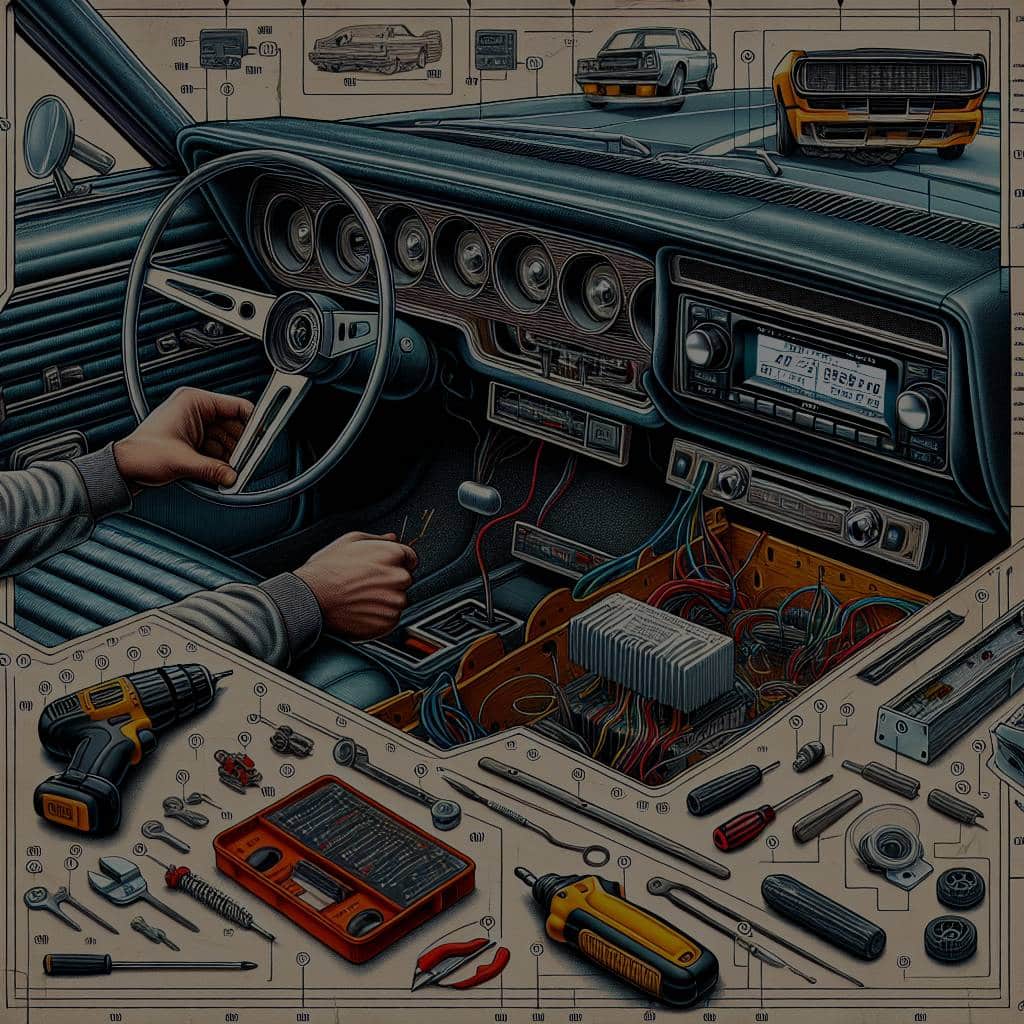How to Retrofit a Modern Infotainment System in a Classic Muscle Car?

Do you own a classic muscle car and cherish the nostalgia it exudes but yearn for the modern technology of today’s automotive experiences? Do you wish you could seamlessly stream your favorite tunes via Bluetooth, navigate using the latest GPS technology, or even make hands-free phone calls? If yes, you are in the right place. This article will guide you on how to retrofit a modern infotainment system into your vintage automobile without compromising its classic appeal.
Identifying a Suitable Modern Infotainment System
The first step in upgrading your audio system is to identify a suitable infotainment system that will blend seamlessly with your classic car’s interior. It’s crucial to find a balance between modern functionality and maintaining the car’s classic charm.
Also to discover : Discover etihad a350 business class offers to India
Companies like Custom Autosound manufacture infotainment systems specifically designed for classic cars. These systems are styled to match the original radio’s appearance while delivering the latest features such as Bluetooth connectivity, advanced audio codecs, and hands-free phone calls.
Look for a system that fits your dash without needing extensive modifications. You wouldn’t want to ruin the dash of your classic by trying to cram in an oversized head unit. Also, consider the system’s power output and ensure it’s sufficient to drive your speakers. A system with lower power output might not deliver the sound quality you desire.
Also read : How to Choose the Right Aftermarket Spoiler for a Honda S2000 for Improved Downforce?
Planning the Installation
Once you’ve identified a suitable system, the next step is planning the installation. You’ll need to consider the wiring, power needs, speaker placement, and potential modifications to the dash.
Start by reviewing the installation manual provided with the infotainment system. This guide will highlight the tools you’ll need and provide step-by-step instructions for the installation process. If the manual is not detailed enough, you may want to consult a professional installer or seek guidance from online forums and video tutorials.
For the wiring, use the wiring diagram in the manual to understand how to connect the system to your car’s electrical system. If your car is very old, you may need to upgrade the wiring to handle the modern system’s power requirements.
Speaker placement is another critical aspect to consider. You’ll need to find suitable locations for the speakers that provide optimal sound whilst preserving the car’s aesthetics. Depending on the size and design of your car, you may need to custom build speaker enclosures or brackets.
Installing the Head Unit and Wiring the System
The head unit is the centerpiece of your infotainment system. It’s the part you’ll interact with the most, so it’s crucial to install it correctly.
First, disconnect the car’s battery to ensure safety during installation. Then, remove the original radio from the dash, taking care not to damage the surrounding trim. If the new system doesn’t fit perfectly, you may need to slightly modify the dash opening.
Next, connect the wiring harness from the new system to the car’s existing radio wiring. If no harness adapter is available, you’ll have to manually connect the wires following the provided wiring diagram.
Ensure that each wire is securely connected and properly insulated to prevent short circuits. After connecting the wires, test the system to verify that everything is working correctly before reassembling the dash.
Adding Speakers and Amplifiers
To get the most out of your modern infotainment system, you may want to upgrade your speakers as well. Modern speakers can handle more power and deliver better sound quality than older models.
When choosing speakers, consider their size, power handling, and sensitivity. Larger speakers typically produce better bass, while speakers with higher sensitivity will deliver louder sound.
If your system’s head unit can’t provide enough power to drive your speakers, you’ll need an amplifier. An amplifier boosts the audio signal from the head unit to the speakers, improving sound quality and volume.
Tweaking the System for Optimal Sound
After installing the infotainment system and speakers, the final step is to tweak the system for optimal sound. Modern systems come with equalizers that allow you to adjust the sound to your liking. You can boost the bass, enhance the treble, or adjust the midrange to achieve the sound you desire.
In addition, modern systems also offer advanced sound processing features like time alignment, which adjusts the sound from each speaker so that it reaches your ears simultaneously, creating a more realistic soundstage.
Remember, the goal is to create a listening experience that complements the classic feel of your muscle car while delivering modern audio performance. So, take your time to experiment with different settings and find the sound that suits your taste.
In conclusion, retrofitting a modern infotainment system in a classic muscle car is a challenging but rewarding project. It requires careful planning, a bit of technical know-how, and patience. However, the end result is a classic car that preserves its nostalgic charm while delivering a modern audio experience.
Optimizing Your Car Radio Experience with Modern Features
Having a vintage car doesn’t mean you have to miss out on the advantages of modern technology. As much as you enjoy the classic appeal of your muscle car, you can still enjoy modern amenities such as Apple Carplay and Android Auto. Features like these are now common in new cars, but with the right tools and preparation, you can integrate them into your classic car’s audio system as well.
Before you start, you need a system compatible with these features. Many recently manufactured car radios or head units offer Apple CarPlay and Android Auto as standard features. These systems are often available in a single din format, which is compact and can easily fit into most vintage car dashboards.
Apple CarPlay and Android Auto allow you to safely use your smartphone’s apps while driving. You can make hands-free calls, send and receive messages, navigate with GPS, and play music or podcasts, all from your infotainment system’s interface.
Ensure the head unit you choose is compatible with your smartphone’s operating system. Some systems may only support Apple CarPlay, while others might only support Android Auto. Some might support both. Once you have your modern head unit in place, all you need is a USB cable to connect your smartphone.
Additionally, to support the seamless integration of these features, you may need to upgrade your car’s electrical system. Classic cars often have older electrical systems that might struggle to provide sufficient power for modern technology. If required, hiring a professional to upgrade your electrical system can be a wise decision to prevent any potential issues.
Ensuring Sound Quality with Sound Deadening
Even with a high-quality audio system, road noise can greatly affect your listening experience. This is especially true for classic cars, which may not have been designed with the same noise reduction considerations as modern vehicles. However, you can reduce this noise by installing sound deadening materials in your car.
Sound deadening materials work by absorbing sound waves, thus reducing the overall noise level in the car. They can be installed in various parts of the car, including the doors, floor, and even the roof. In addition to reducing road noise, sound deadening materials can also improve the audio quality from your car stereo by reducing vibrations and rattles.
There are different types of sound deadening materials, but one common type is a mat that can be cut to size and stuck to the car’s interior panels. Consider using thicker mats for areas where noise is particularly troublesome, like the wheel wells.
Installing sound deadening materials can be a DIY project, but be prepared for a bit of work as it may involve removing interior panels. Also, remember to measure your car’s interior accurately before purchasing materials to ensure you get the correct amount.
In conclusion, retrofitting a modern infotainment system in a classic muscle car can breathe new life into your vintage vehicle. With careful planning and a little bit of elbow grease, you can enjoy the best of both worlds – a car that retains its nostalgic charm while providing a modern, high-quality audio experience. Whether you’re cruising down the highway or sitting in traffic, your car can now offer more than just a stylish ride, but a high-tech journey back in time. Keep in mind that as with any project, patience is key. Don’t rush the process, and soon enough, you’ll be jamming to your favorite tunes in your upgraded classic car.
